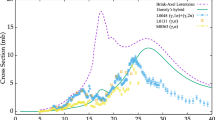Summary
The energy spectra of light nuclides ( 11 H, 21 H, 31 H, 32 He, 42 He) produced in the interaction of 600 MeV protons on various targets (Be, C, Na, Al, Ca, Fe, Au) have been measured at several laboratory angles (30°, 45°, 75°, 105°), by means of ΔE-E telescopes (semiconductor and scintillator detectors). The spectra are fitted with calculated curves derived both from a two-step model and a thermodynamical model of the p-nucleus interaction. Two ranges of nuclear temperature are found: the first one (about (20÷30) MeV) describes the high-energy part of the spectra, the second one (a few MeV) describes the low-energy part (de-excitation of the residual nucleus). These fits are used for the integration over energies and angles, which allows the computation of the total cross-sections and of the fragmentation probabilities. These probabilities are necessary for the study of2H and3He production in the propagation of galactic cosmic rays and their interaction with interstellar matter. We find that the 〈CNO〉 contribution for the production of cosmic He nuclei is not negligible and must be added to the4He contribution. The mean interstellar path length is about 4 g·cm−2. The results obtained with Na and Ca targets should present a biophysical interest.
Riassunto
Si sono misurati gli spettri energetici dei nuclidi leggeri ( 11 H, 21 H, 31 H, 32 He, 42 He) prodotti nell’interazione di protoni di 600 MeV su vari bersagli (Be, C, Na, Al, Ca, Fe, Au) a diversi angoli nel sistema del laboratorio (30°, 45°, 75°, 105°) per mezzo di telescopi ΔE-E (rivelatori a semiconduttori e scintillatori). Gli spettri sono approssimati con curve calcolate dedotte sia da un modello a due stadi che da un modello termodinamico dell’interazione p-nucleo. Si trovano due intervalli di temperature nucleari: il primo (circa (20 ÷ 30) MeV) descrive la parte di alta energia degli spettri, il secondo (pochi MeV) descrive la parte di bassa energia degli spettri (diseccitazione del nucleo residuo). Si usano queste approssimazioni per l’integrazione rispetto alle energie ed agli angoli, che permette il calcolo delle sezioni d’urto totali e delle probabilità di frammentazione. Queste probabilità sono necessarie per lo studio della produzione di2H e3He nella propagazione dei raggi cosmici galattici e nella loro interazione con la materia interstellare. Si trova che il contributo di 〈CNO〉 per la produzione di nuclei cosmici di He non è trascurabile e che deve essere aggiunto al contributo del4He. La lunghezza del percorso medio interstellare è circa 4 g · cm−2. I risultati ottenuti con bersagli di Na e Ca dovrebbero essere interessanti dal punto di vista biofisico.
Similar content being viewed by others
Literatur
J. P. Alard, L. Avan, M. Avan, A. Baldit, J. P. Costilhes, A. Cordaillat, J. Dhermain, L. Fraysse, J. Fargeix, G. Roche andJ. C. Tamain:J. Physique,33, 477 (1972). Let us point out a mistake in Table I: for the experiment «E52 », the kinetic energy of the incoming protons is 22 GeV.
R. Serber:Phys. Rev.,72, 1114 (1947).
M. L. Goldberger:Phys. Rev.,74, 1269 (1948).
R. Hagedorn: preliminary report CERN 67/269/5-TH 751.
R. Hagedorn andJ. Ranft:Suppl. Nuovo Cimento,6, 169 (1968).
R. Hagedorn andJ. Ranft:Suppl. Nuovo Cimento,6, 298 (1968).
J. Frey, P. Laigle andJ. Salmon:Revue Générale de Thermique,105, 1027 (1970).
For the sake of simplicity we keep the same notations as those ofHagedorn, ref. (4–6).
N. Metropolis, R. Bivins, M. Storm, J. M. Miller, G. Friedlander andA. Turkevich:Phys. Rev.,110, 204 (1958).
K. Chen andG. Friedlander:Phys. Rev.,166, 949 (1968).
P. Viallefont: Thèse de III Cycle présentée à l’Université de Clermont-Ferrand, le 25 Octobre 1969 (unpublished).
J. C. Tamain: Thèse de III Cycle présentée à l’Université de Clermont-Ferrand, le 12 Novembre 1971 (unpublished).
J. P. Alard, P. Viallefont, G. Roche, C. Motta, J. P. Costilhes, A. Cordaillat andA. Sicre:Compt. Rend.,268, 1276 (1969).
A. Baldit: Thèse de III Cycle présentée à l’Université de Clermont-Ferrand, le 24 Octobre 1972 (unpublished).
K. Huang:Statistical Mechanics (New York, N. Y., and London, 1963).
A. M. Poskanzer, G. W. Butler andE. K. Hyde:Phys. Rev. C,3, 882 (1971);4, 1759 (1971).
G. Roche, J. P. Costilhes, J. P. Alard, A. Baldit, J. Dhermain, J. Fargeix, L. Fraysse andJ. C. Tamain:Nucl. Inst. Meth.,101, 231 (1972).
J. P. Alard et al.: to be published.
Results concerning aluminium targets have been given byA. M. Poskanzer in a private communication.
S. T. Butler andC. A. Pearson:Phys. Rev.,129, 836 (1963);Phys. Lett.,9, 930 (1964).
N. Kurtz:Nuovo Cimento,38, 141 (1965).
I. Dostrovky, P. Rabinowitz andR. Bivins:Phys. Rev.,111, 1659 (1958);E. Jeannet: Thesis, University of Neuchatel (1963) (unpublished).
V. I. Bogatin, A. I. Vikhrof, E. L. Grigoriev andO. V. Lozhkin: preprint V. G. Kklopin Radium Institute, Leningrad, I-7653.
M. Nadi andF. Riad:Nucl. Phys.,50, 33 (1964).
C. D. Kavalovski, G. Bassani andN. M. Hintz:Phys. Rev.,132, 813 (1963).
L. E. Bailey: preprint UCRL-3334 (1956).
Cherby et al.: private communication.
M. Honda andD. Lal:Phys. Rev.,118, 1618 (1960).
L. A. Currie, W. F. Libby andR. L. Wolfgang:Phys. Rev.,101, 1557 (1956).
E. L. Fireman andF. S. Rowland:Phys. Rev.,97, 780 (1955).
L. A. Currie:Phys. Rev.,114, 878 (1959).
R. Ramaty andE. Lingenfelter: Goddard Space Flight Center, April 1968, X-611-68-144, preprint.
M. M. Shapiro:Composition and galactic confinement of cosmic rays, invited paper,XIV General Assembly of the International Astronomical Union, University of Sussex, August 26, 1970.
J. P. Meyer:XII International Conference on Cosmic Rays (Hobart, 1971).
V. L. Ginzburg andS. I. Syrovatskii:The Origin of Cosmic Rays (Oxford, London, and New York, N. Y., 1964).
M. Chevarier: private communication.
Kunz andSchintlmeister:Nuclear Tables, Part II, Vol.1 (Oxford and London).
Author information
Authors and Affiliations
Additional information
To speed up publication, the authors of this paper have agreed to not receive the proofs for correction.
Work supported in part by the Institut National de Physique Nucléaire et de Physique des Particules.
Rights and permissions
About this article
Cite this article
Alard, J.P., Baldit, A., Brun, R. et al. Light-fragment production in p-nucleus interactions at 600 MeV. Astrophysical application. Nuov Cim A 30, 320–344 (1975). https://doi.org/10.1007/BF02730175
Received:
Published:
Issue Date:
DOI: https://doi.org/10.1007/BF02730175




